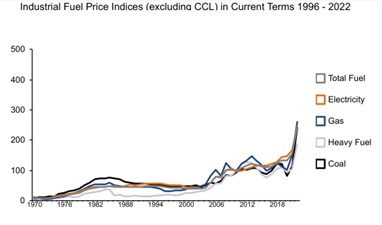Making the business case for investing in sustainability improvements to food manufacturing plants
8 June 2023
Interest in sustainability projects in the Food Manufacturing sector has been on the up in the past 5 years and particularly following the recent spike in power and energy costs in 2022.

(Source – UK Gov Dept of Energy Security and Net Zero)
This has been compounded by the fact that the installation cost of renewable energy has dropped significantly and steadily over the past decade. Renewables are now truly competitive with traditional energy sources, and on-site generation can provide the added benefits of security of supply in an increasingly uncertain world. We are now seeing compelling sustainability arguments being turbo charged by supporting the financial business and risk management cases.

So how do we assess the impact of a Sustainability initiative on the business both in terms of CSR objectives and hard financial benefits? Here is a checklist to help quantify the impact and full value of the benefits that should be included in the business case:
- Identify Associated Sustainability Metrics in three ways;- Determine the specific sustainability metrics relevant to your business case; such as energy consumption, water usage, waste reduction, carbon emissions. These metrics should be articulated as absolute values (i.e. te or KWH), percentages of site totals and cost based values (i.e £/te or £/KWH). These metrics will serve as a basis for measuring the impact and financial value of sustainability initiatives.
- Articulate Net Cost and Carbon Savings per tonne of finished product ;- Evaluate the potential cost savings and carbon savings resulting from the sustainability initiative. Look to articulate this as a reduction in the cost or carbon cost per tonne of finished product. The same approach can be used with water- and waste-based initiatives.
- The Impact of Efficiency is broader than you think: Whilst there is a strong, direct correlation between operational efficiency and environmental impact there are many ways to measure a business’ efficiency. For example look at all the areas that impact overall efficiency, i.e improvements to process efficiency, improvements that reduce downtime or enhance productivity. Quantify the anticipated improvements and their financial implications, such as increased production capacity, reduced maintenance costs, or improved supply chain reliability.
- Assess Brand Reputation and Market Opportunities: Consumer preferences are increasingly shifting towards environmentally and socially responsible businesses. Allude to the potential for positive impact on customer loyalty and market differentiation.
- Quantify Intangible Benefits: Acknowledge that not all benefits can be easily quantified. Some sustainability benefits, such as employee satisfaction, community engagement, or improved stakeholder relationships, are intangible but still contribute to long-term business value. While challenging to measure in monetary terms these should also be included in the business case.
- Calculate Return on Investment (ROI): Based on the financial benefits and costs identified, calculate the ROI of sustainability initiatives. Compare the net financial gain resulting from sustainability measures against the investment required. Now do the same thing as a Carbon return.
- Consider the enhanced potential resale value of the asset; One of the often missed balance sheet benefits of some sustainability projects is that they can positively impact the realisable value of an asset. For example, additional sustainability measures, such as renewable power generation systems, can increase the value of the asset should it ever need to be sold.
- Getting ahead of the regulatory compliance curve: Look to see if the initiative will be covered in proposed future legislation. There will be increased pressure on industry to adopt measures that support the UK’s ambition to get to net zero.
Remember that the exact approach to quantifying the value of a sustainability project will vary depending on a number of external factors. A comprehensive feasibility study for larger projects should include these factors to support decision-making.
